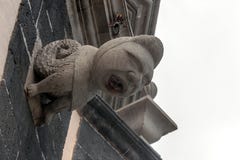
Most, although not all, portrayed a single face or figure with a demonic or animalistic bearing some buildings had dozens incorporated into their design. Unlike the sculpted corbels and other such features of earlier buildings, however, medieval grotesques and gargoyles had no structural or protective supporting role, existing either as drainage spouts or as grimacing artworks in their own right. But what are they exactly, why are they there and how did these imps in the guttering come to play a role in formal architecture? Just as the carvings themselves take all manner of different forms - from snarling dragons and scabrous man-beasts to wild-haired rogues and grinning gremlins, even ones which we might recognise as aliens - there’s a tangle of different theories and answers. Gargoyles and grotesques still stare down from many a church, cathedral, college and country home. Very few of them have what you’d call a benevolent gaze. They are stone made ugly, their face-ache features frozen into cackling disdain for the weak humans below. Some have horns, others have fangs or lewd, lolling tongues. They leer down at us as if they know something we don’t, their nostrils flared and their teeth bared.

It’s all very ordered and all very charming - except for the gruesome faces on the roofline. Here’s the porch, here’s the steeple, here’s the parish noticeboard. Inevitably hideous-looking and often mischievous, why do gargoyles and grotesques adorn some of our most solemn churches, asks Ben Lerwill.



 0 kommentar(er)
0 kommentar(er)
